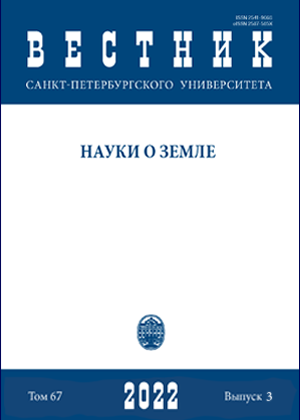Assessing the risks of spatial disintegration in a state with a multinuclear territorial and political structure (on the example of Bolivia)
DOI:
https://doi.org/10.21638/spbu07.2022.305Abstract
The assessment of the risks of spatial disintegration is carried out on the basis of the methodology developed by the authors. The methodology makes it possible to quantify the danger of weakening, disruption and destruction of the system-forming links between the administrative-territorial units of the country. The authors have identified seven factors of spatial disintegration: historical, socio-economic, domestic political, ethno-cultural, military-strategic, transport and foreign policy.
As an example of testing this technique, Bolivia was chosen as a state that has patterns of economic, political, socio-cultural development characteristic of most Latin American countries. But unlike most of them, Bolivia has a multi-core territorial and political structure: in the political field, the actual (La Paz) and constitutional (Sucre) capitals compete with an alternative pole of growth – the city of Santa Cruz de la Sierra in the flat east of the country. The Santa Cruz Department initiates and coordinates various innovations and projects aimed at increasing the autonomy of the east of the country or federalization of Bolivia.
The calculations have shown that Bolivia has significantly higher risks of potential disintegration compared to several Latin American states (Mexico, Venezuela, Chile). Modern Bolivia is a contradictory system of two heterogeneous socio-cultural, economic and political regions – the mountainous West, inhabited by Aymara and Quechua, that economic development is based on the mining industry, and the plain East, populated by Creoles and Guarani, economically stimulated by natural gas production and more intensive agriculture. It is determined that the departments of Santa Cruz and Tarija have the greatest risks of spatial disintegration within Bolivia.
Keywords:
Bolivia, spatial disintegration, separatism, Santa-Cruz, risks of disintegration
Downloads
References
Бьюкенен, А. (2001). Сецессия: право на отделение, права человека и территориальная целостность государства. М.: Рудомино.
Воротникова, Т. А. (2019). Политические конфликты в мультиэтническом обществе: созидательный потенциал и риски поляризации для Боливии. PolitBook, 1, 169-180.
Иванов, А. (2006). Равнинные боливийцы хотят быть выше горных. Коммерсант. [online] Доступно на: https://www.kommersant.ru/doc/730455 [Дата доступа 13.01.2022].
Кретов, С. М. (2016). Федерализм как способ гармонизации интересов боливийского Востока и Запада. Политическая наука, 1, 147-160.
Ларин, Е. А., Щелчков, А. А. (2015). История Боливии с древнейших времен до начала XXI века. М.: Наука.
Попов, Ф. А. (2015). Дробление политического пространства мира: основные формы и современные тенденции. Региональные исследования, 2, 64-73.
Пятаков, А., Чернышев, А. (2011). Риски политической нестабильности в странах «социализма XXI века». Латинская Америка, 2, 22-37.
Себенцов, А. Б., Колосов, В. А. (2012). Феномен неконтролируемых территорий в современном мире. Полис, 2, 31-46.
Скачков, В. С. (2021). Дезинтеграция государственного пространства стран Латинской Америки: факторы и методика оценки. В: Социально-экономическая география: теория, методология и практика преподавания: материалы Всероссийской научно-практической конференции с международным участием. Шестые Максаковские чтения, г. Москва, 14 мая 2021 г. Барнаул: ИП Колмогоров И. А., 261-270.
Туровский, Р. Ф. (1995). Политико-географический анализ политического процесса: Теоретико-методологические аспекты. Автореф. … дис. канд. полит. наук.
Харламенко, А. В. (2013). Сепаратизм в Боливии и Эквадоре начала XXI в. Латинская Америка, 12, 53-59.
Agencia de Noticias Fides (2021). Camacho asegura que el modelo del MAS se agotó y propone el federalismo para Bolivia. [online] Available at: https://www.noticiasfides.com/nacional/politica/camacho-asegura-que-el-modelo-del-mas-se-agoto-y-propone-el-federalismo-para-bolivia-412562 [Accessed 20.01.2022].
Agnew, J. and Mamadouh, V. (еds) (2008). Politics: Critical Essays in Human Geography. London: Routledge. https://doi.org/10.4324/9781315246512
Antelo, S. (2003). Los cruceсos y su derecho de libre determinacion. Santa Cruz: Imprenta Landivar.
Assies, W. (2009). La “media luna” sobre Bolivia: nación, región y clase social. Revista De Metalurgia, 43, 87-105.
Centellas, M. (2015). The Santa Cruz Autonomía Movement in Bolivia: A Case of Non-indigenous Ethnic Popular Mobilization? Ethnopolitics, 15 (2), 245-264.
Countries of the World (2020). Countries of the World. [online] Available at: https://theodora.com/pipelines/argentina_bolivia_brazil_chile_ecuador_peru_uruguay_pipelines_map.html [Accessed 20.01.2022].
Economist Intelligence, EIU (2021). Democracy Index. [online] Available at: https://www.eiu.com/n/campaigns/democracy-index-2020/[Accessed 20.01.2022].
Espinoza, F. (2015). Bolivia: la circulación de sus élites (2006-2014). Editorial El País.
Flesken, A. (2017). Identity change in a context of intergroup threat: Regional identity mobilization in Bolivia. Politics, 38, 51-67.
Fragile State Index (2021). Fragile State Index. [online] Available at: https://fragilestatesindex.org/2021/05/20/fragile-states-index-2021-annual-report/[Accessed 20.01.2022].
Global Data Lab (2021). Subnational HDI. [online] Available at: https://globaldatalab.org/shdi/shdi/BOL/[Accessed 20.01.2022].
Gottmann, J. (2005). La politique des États et leur géographie. Paris: CTHS.
Instituto Boliviano de Comercio Exterior (2016). Inversion Extranjera Directa por ano segun departamento (1996-2005). [online] Available at: https://repositorio.cepal.org/bitstream/handle/11362/40213/7/S1600664_es.pdf [Accessed 20.01.2022].
Instituto Nacional de Estadistica (2012). Censo Nacional de Población y Vivienda 2012. [online] Available at: https://www.ine.gob.bo/index.php/estadisticas-sociales/vivienda-y-servicios-basicos/censos-vivienda/[Accessed 20.01.2022].
Jones, S. B. (1954). A unified field theory of political geography. Indianapolis: Md, Bobbs-Merrill.
Lowrey, K. (2006). Bolivia Multiétnico y Pluricultural, Ten Years Later. Latin American and Caribbean Ethnic Studies, 1, 63-84.
Mamani Ramhrez, P. (2020). Wiphalas, luchas y la nueva nacion. Relatos, analisis y memorias de octubre-noviembre de 2019 desde El Alto, Cochabamba y Santa Cruz. [online] Available at: http://library.fes.de/pdf-files/bueros/bolivien/16622 [Accessed 24.04.2022].
Pruden, Н. (2018). Santa Cruz de la Sierra: de campañas separatistas y proyectos integracionistas, entre las postrimerías y la posguerra del Chaco (1935-1939). Res Gesta, 54. [online] Available at: https://repositorio.uca.edu.ar/handle/123456789/5810 [Accessed 20.01.2022].
Red Nacional de Televesion (2020). Tarija: UNIR y MNR anuncian alianza política para las elecciones subnacionales. [online] Available at: https://www.atb.com.bo/política/tarija-unir-y-mnr-anu [Accessed 13.01.2022].
Taylor, Peter J. and Flint, Colin (2000). Political geography: world-economy, nation-state and locality. Harlow: Prentice Hall.
Tockman, J. and Cameron, J. (2014). Indigenous Autonomy and the Contradictions of Plurinationalism in Bolivia. Latin American Politics and Society, 56, 46-69.
Downloads
Published
How to Cite
Issue
Section
License
Articles of "Vestnik of Saint Petersburg University. Earth Sciences" are open access distributed under the terms of the License Agreement with Saint Petersburg State University, which permits to the authors unrestricted distribution and self-archiving free of charge.






